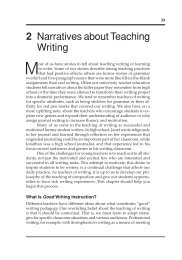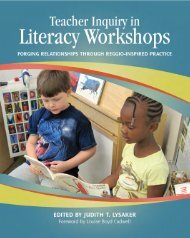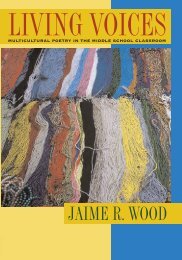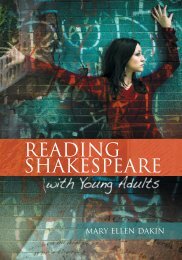Graphic novel Spread - National Council of Teachers of English
Graphic novel Spread - National Council of Teachers of English
Graphic novel Spread - National Council of Teachers of English
- No tags were found...
Create successful ePaper yourself
Turn your PDF publications into a flip-book with our unique Google optimized e-Paper software.
6 James Bucky Carter<br />
around them” (p. 582). Although students weren’t informed <strong>of</strong> them,<br />
the goals <strong>of</strong> the project aligned with New York State’s Learning Standards<br />
for <strong>English</strong> Language Arts, and Bitz’s publications explore how<br />
each standard was met (p. 584). In examining implications for teachers,<br />
Bitz explains:<br />
Many <strong>of</strong> the manuscripts highlighted how students corrected and<br />
revised their own work, or demonstrated opportunities for instructors<br />
to show students where mistakes were made on a small<br />
scale (grammar and mechanics) or a large scale (story structure<br />
and thematic consistency). Also, one can observe noticeable improvement<br />
in writing from the manuscripts to the final comic<br />
books—mechanical errors were fixed, story structures were tightened,<br />
and character voices were honed. . . . The Comic Book Project<br />
seemed to have most marked effect on children with limited <strong>English</strong><br />
pr<strong>of</strong>iciency. . . . According to instructors, these children’s<br />
manuscripts and comic books represent more writing than they<br />
had produced in <strong>English</strong> class throughout the entire school year.<br />
(p. 585)<br />
It is <strong>of</strong> interest to note that, whereas comic books are most known either<br />
for superpowered individuals wearing tights and fighting other<br />
equally powered and similarly attired foes or for the go<strong>of</strong>y and humorous<br />
characters who led to the genre’s name (first “funnies,” then “comics”),<br />
many students in The Comic Book Project created works in formats<br />
more advanced and more readily recognized as valuable in the<br />
<strong>English</strong> language arts community: authentic texts and autobiographical<br />
sketches. Indeed, in this regard, their comics are actually more like<br />
graphic <strong>novel</strong>s (with many sterling examples <strong>of</strong> the form being autobiographical)<br />
than comic books.<br />
In addition, <strong>English</strong> language learners’ (ELL) interaction with<br />
comics has recently received attention in the TESOL Quarterly. Jun Liu<br />
reports that low-level students who received a high-level text with a<br />
comic strip “scored significantly higher than the low-level students receiving<br />
the high-level text only” (2004, p. 235). Although the comic strips<br />
that Liu’s students used did not help comprehension in all cases, this<br />
outcome is still impressive and echoes Bitz’s findings that comics can<br />
aid ELL populations in certain circumstances. Also worth noting in the<br />
Liu study is the talk <strong>of</strong> dual coding studies by the likes <strong>of</strong> Gambrell and<br />
Jawitz (1993) and Mayer (1999), who “found that words and pictures<br />
together produced better recall and transfer than either did alone, and<br />
that individual differences in ability were a factor” (Liu, 2004, p. 228).<br />
Dual coding is emerging as a theory that will no doubt provide even
















